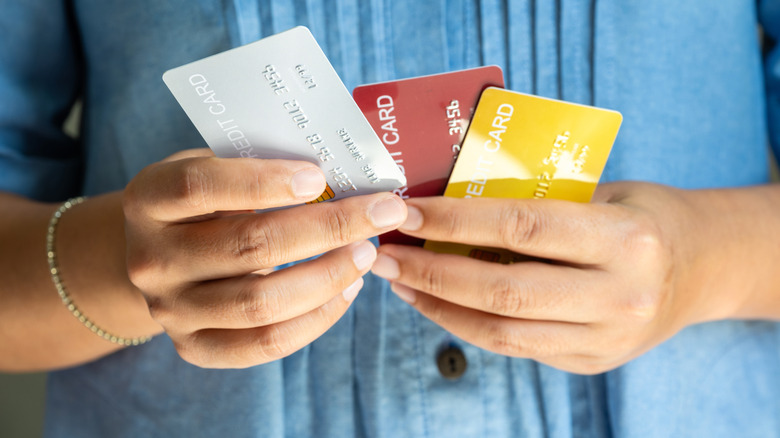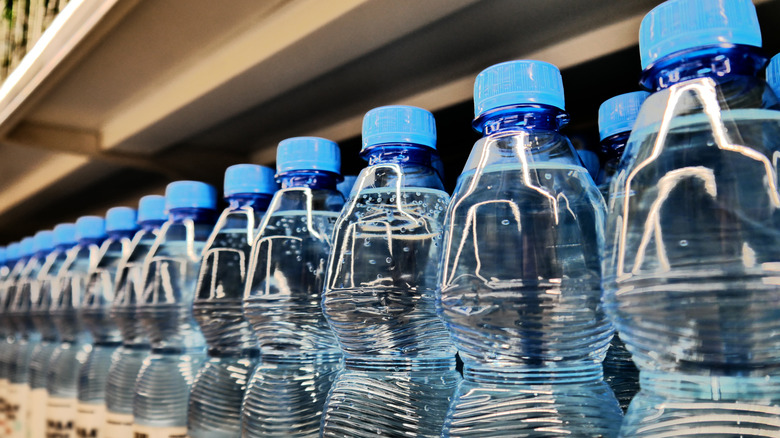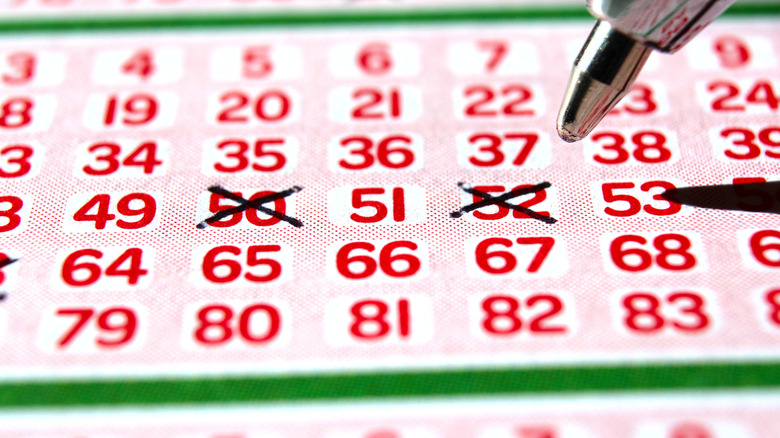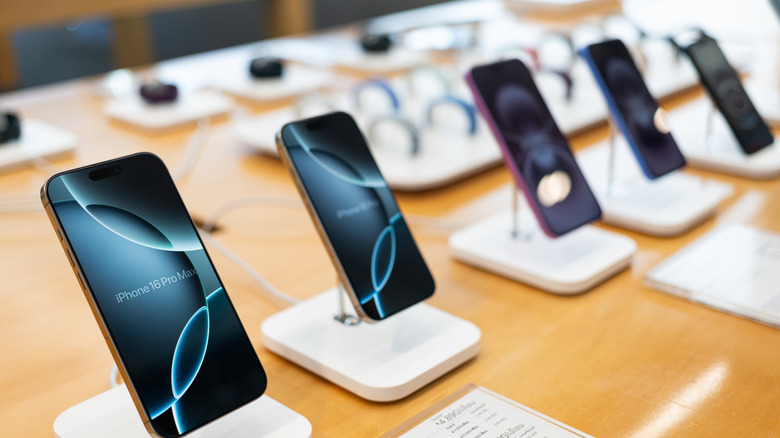X Items 'Upper-Class' People (Almost) Never Spend Money On
The upper class is a financial designation that often evokes a pretty particular image. Many people picture wealthy individuals who aren't afraid to show off their fiscal prowess by splurging on luxury consumer items, gaudy vacations, and exceedingly comfortable and lavish lifestyles. But, in reality, those in the upper class are frequently people who have some crucial financial literacy chops to back up their high earnings or significant inheritances. People who find themselves in the world of the wealthy really only have two choices in front of them: Adopt frugal and intelligent budgeting habits to continue growing their wealth, or start spending it all on luxuries in the present. Anyone can wind up living paycheck to paycheck, and Goldman Sachs reports roughly 40% of high earners raking in over $300,000 count among this group. So, being upper class takes more than a nice salary: You also need to have good financial flexibility, and solid monetary decision making skills to help ensure you can live a consistent lifestyle with some degree of predictability.
For that reason, many folks in the upper class are surprisingly frugal. They don't necessarily drop big bucks on all the newest and best technology unless the purchase adds definitive value to their lifestyle, and they might avoid unnecessarily fancy accommodations or entertainment. While the mental image of an upper-class American might look flashy and fabulous, there are actually quite a few luxuries that upper-class people don't typically spend their money purchasing.
Expensive cars
The expensive car is a strange quirk in the modern consumer landscape. This luxury item is frequently seen flaunted around on social media and out in the real world, too. There's something visually magnetic about luxury automobiles. People stop and look at them, and when it comes to really exotic models, you may even see pedestrians taking pictures with certain vehicles they pass on the street. Society seems to have an embedded idea that this particular status symbol is uniquely important and valuable. But the reality is that an expensive car is just that, a status symbol. Many people in the upper class understand that an expensive mode of transportation is actually less valuable than a more cost-effective solution in the grand scheme of things.
People who find themselves in the upper class are actually more likely to appreciate the reality that cars are primarily designed to serve individual transportation needs, rather than acting as a means of flaunting wealth. These individuals often tend to save money on what can easily devolve into a vanity project. Some prominent examples of uber-wealthy drivers who have steered clear of the luxury auto game include Warren Buffett and Alice Walton.
Consumer credit card debt
The Federal Reserve Bank of San Francisco reports over 80% of American adults have at least one credit card as of 2022, and the upper class is certainly among them. But while credit card usage may transcend class divides, how people leverage lending tools in general very much depends on individual wealth. While most people in America can utilize credit, people in the upper class have plenty of additional options available to them beyond the standard credit card that most citizens use for this purpose.
Wealthier individuals are more likely to own their own home, for instance, with homeowners enjoying wealth ballooning to as much as 40 times that of typical renters. Homeownership is a critical marker of both the middle class and upper class in the United States, and building equity in a property allows you to tap into that financial value to use products like a refinancing opportunity or a HELOC. These kinds of lending products deliver greater flexibility than a standard, consumer credit card. They also come with lower interest rates. Credit cards carry some of the highest interest rates across any debt product you can tap into. Members of the upper class are keenly aware of this fact, and avoid leaning on credit card accounts whenever possible. Specifically, they are allergic to carrying balances over from month to month and will do everything in their power to avoid it and the interest additions that come along for the ride.
Useless insurance and warranty policies
Insurance and warranty coverage options for routine consumer purchases are often useless add-ons that only serve to pad the profits of the company selling the goods. In some cases, warranty policies do not provide coverage for the things you'll actually need to fix. For instance, some insurance policies on appliances may not cover cosmetic damage. This means that if you scratch the surface of your stove or dent the side of your fridge while opening the door, you aren't going to get replacement parts included in the policy. Ultimately, many buyers actually find that they are better off purchasing these kinds of items with their credit card, then paying off the expense right away. This builds in additional consumer protections that may not be there otherwise.
Instead of adding policies, some buyers consider only purchasing items that come with extended manufacturer's warranties. These may even provide more coverage than the one offered by the retail store. Another approach might be to start saving a little bit at a time for the replacement you'll eventually need when you buy a new item. Angi reports the typical dishwasher today runs an average of $1,300, and even lower-end options run consumers around $400. They also last around ten years. That means if you save $130 every year — roughly $11 per month — in an "insurance pot" for your consumer goods, you'll arrive at the value of your unit right around the time you'll need to start thinking about a replacement.
Bottled water
This one is almost certainly going to rile up plenty of consumers. It's well known that bottled water is one of the most marked-up consumer goods you'll find on store shelves. You can pay as much as 4,000% in markups for a bottle of water, and what you get in exchange is often just filtered tap water closely resembling what pours out of your kitchen sink. This fact alone is enough to cause upper-class consumers to invest in reusable water bottles and avoid paying the upcharge whenever possible. Even though a bottle of water only costs a few dollars on average, the extreme gap in price versus value can really add up over the long term.
Where bottled water becomes problematic actually isn't in the price tag. This is, at its heart, a spending problem that has more to do with systematic inequality than poor choices. Studies have shown that lower-income communities tend to exhibit a higher likelihood of poorer quality tap water. In much the same way that lower-income individuals are more likely to live near airports and suffer physical health complications due to the noise pollution and air quality, poor tap water quality directly impacts an individual's quality of life. So, many people in lower-income neighborhoods need to invest in bottled water for their own health, while those in more well-off communities can simply turn on the faucet and assume that clean water is flowing into their cup, shower, or onto their toothbrush.
Playing the lottery
The lottery is an oddity, to be sure. The average American spends around $400 every year on lottery tickets, despite the knowledge that their chances of winning a jackpot draw are astronomically small. Still, millions of people regularly buy lottery tickets, buying into the dream that their numbers will be pulled in just the right sequence and they'll walk away with millions or more. Of course, many argue that, if you don't buy a ticket, your chance of winning a jackpot draw will always be zero. While that's true, it's actually more likely that you'll be struck by lightning on numerous occasions than possess the winning lottery numbers of one of these mega draws. In fact, the reason lottery winnings can get so high in the first place is that so few people win.
Meanwhile, people in the upper class don't fantasize about becoming rich, because they already exist within that bubble. Sure, winning a huge lottery draw would skyrocket their wealth, too, but these individuals see the lottery for what it is and accept that the chances of winning are virtually non-existent. Plenty of Americans only buy lottery tickets when the figure becomes truly incomprehensible. Most people won't have any gripes with buying a $2 lottery ticket when the potential payout is in the billions — though buying a ticket with a credit card can come with added costs. So, if you want long-term wealth, keeping lottery ticket purchases minimal is the smart play.
Brand new tech commodities
Upper-class people don't always feel the need to show off their latest purchases. It's the reason why they don't typically drive flashy, new cars, and the same frugal mindset extends to other spending categories as well. One area where this can be particularly felt is in the tech world. Apple, Samsung and numerous other brands that help feed our entertainment and productivity tend to release new and exciting phones, watches, laptops, and tablets on an annual basis.
Technology is always changing, and in many areas of this marketplace, new releases often suffer from shallow feature depth, buggy user experiences, and gimmicky inclusions that feel cool but don't actually solve problems that users face. A prime example of this phenomenon is Samsung's introduction of Bixby in 2017. While initially designed to make life easier, many Samsung users have ultimately found the voice-controlled virtual assistant useless and annoying. While Bixby's been retooled and improved over the years, many potential buyers in wealthy communities may have held off at first. Frugal upper-class shoppers tend to wait until a product's developed to the point that it will actually improve their lives, rather than jumping on the newest fad. Moreover, waiting allows you to expand your options when it actually comes time to buy something. Regardless of the brand you prefer, odds are you could get this year's new phone at a lower price next year — a newer model that suits your needs better might even come out in that time.
The latest kitchen equipment
Kitchen gear is a major consumer spending area that, much like other consumer technology, is seemingly always benefitting from new innovations and providing new approaches to the same old process of cooking a meal. Ninja, for instance, makes at least one flashy new product every year. Whether it's an air fryer or a blender, the newest models promise a revamped experience that far surpasses the capabilities of existing units. Many people get sucked into this vision of improved processes in the kitchen, and those running busy households are particularly swayed by the marketing campaigns of these brands. This popularity makes sense: After all, a product's ability to speed up food prep and possibly even leave users with more down time day to day is an easy sell for many.
But kitchen gear suffers from the same marketing trend as other technology: A new piece of cooking equipment tends to be pretty expensive, and even though many of these tools get advertised as great new additions in your kitchen, they often do largely the same job as older models. Meanwhile, upper-class cooks might keep their gear limited to exactly what they need and stick with it. There's nothing wrong with buying an expensive tool if it regularly adds value to your life, but if you already have a good blender, there's no need to buy a new one just because it comes with one extra attachment.
Airline seat upgrades without specific purposes
Upper-class people aren't unfamiliar with business- and first-class cabins on airplanes. These seats cost notably more than a standard coach ticket, so people with more money tend to invest in these luxury upgrades. The average first-class flyer's net worth is usually pretty high, after all. Many people sell the idea to themselves that it's worth buying the upgrade when going on a special vacation, but this purchase comes as a powerful, visual symbol of class differences baked into the travel experience. When boarding a plane, you'll often catch a glimpse of the comfortable seats before heading to the back of the aircraft. Having this experience over and over could cause a fed-up consumer to treat themself with a first- or business-class plane ticket as soon as they get a bonus or a new raise, regardless of whether it's financially responsible to do so.
The thing about business class is that many reasons impact a decision to upgrade. Those in the upper class may be flying on the company's dime, or choose an upgrade because it adds value to their specific travel needs during that flight. There are some flyers who refuse to sit in coach, but many upper-class individuals are perfectly fine there unless it's especially practical to upgrade. For example, upgrading a ticket if you're flying overnight could give you a better shot at resting on the flight and having more energy when you land.
Bank fees
This is a simple one: There is no need to pay just about any bank fee. Even so, the 2021 FinHealth Spend Report claims that middle- and lower-class consumers still pay $255 billion collectively in bank maintenance fees, accounting for 84% of fees and interest for financial services paid in total. These are often baked into the terms and conditions of your checking account, and may kick in when you don't have a direct deposit coming into the account or maintain a preset minimum balance. However, there is a genuine wealth of banking options out there to help consumers cut out these frivolous expenses.
Moving to an online bank, rather than a brick and mortar service, can help cut these kinds of expenses out of your budget. However, some large institutions have also done away with service fees baked into their costs to customers. If you're being charged fees, it's worth exploring alternatives because there's just no need to accept this treatment. Upper-class individuals understand this and actively make decisions that eliminate these small but frustratingly unnecessary costs. On a similar note, it's also worth mentioning that plenty of unbanked people experience a different kind of fee structure incurred by the constant weight of inflation. By keeping your money in cash, you lose out on interest rates and other tools that protect you against this steady hollowing out of a physical dollar's value. Naturally, the upper class are rarely the ones storing their finances in this manner.
Lots of subscriptions
Subscription services can add up quickly. The average person in America pays around $1,000 every year to maintain between four and five services. There are many subscription models out there, and plenty of Americans wind up paying for services long after they stop using them. People in the upper class are more likely to keep an eye on their subscription expenditure, preventing unused subscriptions from falling through the cracks and continuing to get charged without being noticed.
Fortunately, canceling unused subscriptions or consolidating memberships is something that everyone can do. There are many opportunities to bundle subscriptions to save on multiple monthly fees at once. For instance, signing up for Walmart+ gets you free monthly access to Paramount+ or Peacock — and you'll avoid some huge mistakes costing you money at Walmart while you're at it. If you pay annually for the service, you'll save even more, and wind up paying roughly what you would have for the streaming service alone. If you're already a subscriber to one of these streaming services, canceling your existing subscription and getting it through this Walmart workaround is a no-brainer. Staying aware of deals like this, and seeking out ways to eliminate expenses you're not using, is an extremely healthy practice if you want to live the life of the upper class.










